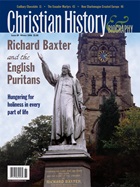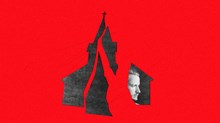Oldest church discovered?
In seminary, we learned that the Roman Christians didn't start erecting public church buildings until after Constantine legalized their faith in 313 A.D. As a result, almost all evidence from the first three centuries of the church has come to us in the form of manuscripts, not architecture or furnishings. Now archaeologists have uncovered a building in the northern Israeli city of Megiddo, near the biblical site of Armageddon, that challenges the conventional wisdom.
Imagine the scene. Prisoner Ramil Razilo, serving two years for traffic violations, is carefully removing rubble in a last-minute archaeological test dig before destroying the ground to expand their prison. Suddenly, his shovel hits the edge of an elaborate mosaic. As workers uncover first the tiled floor, then remnants of a table, and then a set of Greek inscriptions, signs increasingly indicate that this is the first pre-Constantinian church ever discovered.
No important antiquities discovery seems to go undebated, however. Evidence favoring the early date include the fish symbol, used by persecuted Christians; some older potsherds; the style of Greek writing in the inscriptions; the geometric patterns used in the mosaics; and the style of the building itself.
Among those scholars arguing against the conclusion that this as a pre-Constantinian church is Joe Zias, anthropologist and ex-curator with the Israel Antiquities Authority. Though Zias believes the building may date back to the third century, he suspects it was converted to a church later. For one thing, one of the inscriptions names a Roman officer as a benefactor. "If I were a Roman soldier in the third century," said Zias, "I certainly wouldn't want my name on [a church]. … This would not have been a good career move. In fact, it sounds like the kiss of death."
(Our thanks to CTI staffer Rich Tatum, who gathered much of the above information on his blog: Google "blogrodent and Megiddo" for more.)
On the big screen
A new crop of feature films draws from Christian history for story material—and hopefully will draw viewers to dig into their history books to learn more.
Fifty years ago, five young missionaries flew into a remote jungle in Ecuador and were killed by the Waorani tribe, then called the "Auca" Indians. In the years that followed, members of the tribe converted to Christianity and repudiated their violent ways. Just released in theaters, End of the Spear tells the story from the viewpoint of the Waorani. The studio (Every Tribe Entertainment) has also made available on DVD its award-winning documentary Beyond the Gates of Splendor. For a historian's commentary on the events that inspired the film, see Long and Nystrom's article, "Martyrs to the Spear," on p. 43 of this issue.
Another upcoming film, Amazing Grace, currently being shot by Walden Media (the company that partnered with Disney to produce The Chronicles of Narnia), will tell the story of hymnwriter/abolitionist John Newton and his protégé William Wilberforce, who campaigned for three decades to end the slave trade in England. [See CH&B Issue 81 on Newton and Issue 53 on Wilberforce.]
Also drawing from Christian history is Martin Scorsese's next movie: an adaptation of Shusaku Endo's Silence. The novel follows a pair of 17th-century Portuguese missionaries into Japan, where preaching Christianity was punishable by death.
Centuries-old banned book resurfaces
"Forced religion stinks in the nostrils of God." Saved from the flames of religious repression over 350 years ago, a rare first edition of the revolutionary book bearing these words recently resurfaced.
In 1644 Roger Williams, original theorist of the separation of church and state, traveled to London to print his classic call for religious toleration, The Bloudy Tenent of Persecution. Parliament ordered copies of the book burned, but Williams saved some and brought them back to Rhode Island.
This August, when Phoebe Simpson, a librarian at the Rhode Island Historical Society, opened some other historical writings on a shelf with rare books, she discovered one of the few 1644 editions of Bloudy Tenent that remain (only five other copies of this edition are known to exist). "I just broke out in goose bumps," Simpson said in an interview. "It was the pure excitement of touching something that Roger Williams touched."
Williams came to the Massachusetts Bay Colony in 1631. A man ahead of his time, he interpreted the bloody religious strife of 16th- and 17th-century Europe as a warning from God against mixing religion and politics. After he extended this disestablishmentarian critique to the colony itself, he was banished and forced to seek refuge in the wilderness. There, he purchased a tract of land from the Native Americans and founded Rhode Island.
Two museums link Asian Christians to the West
A great task lies ahead for all Christians: to move toward mutual understanding across the global church's many cultures. Today, two museums are playing their roles in linking Asian and Western Christians.
The Korean Christian Museum at Soongsil University in Seoul, South Korea, is the first museum in that country to tell the story of how Christianity vitalized Korean culture after it officially reached the peninsula around the 17th century. Among the sculptures, books, and other artifacts is a copy of John Bunyan's Pilgrim's Progress translated into Korean in the 19th century. The museum also holds a large collection of relics brought in through China between the 7th and 8th centuries, including a 7th-century Nestorian stone cross excavated in Gyeongju.
Meanwhile, in North Chatham, Massachusetts, another museum draws Japanese "pilgrims." These visitors come to the Chatham Historical Society's Atwood House Museum to remember a sea captain who was instrumental in helping a young Japanese man reach America in 1865. Captain Horace Taylor brought young Shimeta Neesima to America aboard his ship, the Wild Rover, represented in a painting at the museum. Neesima was one of the first Japanese to escape the country during its years as a closed society. Receiving a sought-after Christian education in America, Neesima was eventually ordained as a Congregational minister at Mount Vernon Church in Boston and then returned to Japan to found, in 1875, one of its first Western-style universities, Doshisha University in Kyoto. Today, Neesima is remembered as one of Japan's greatest Christian leaders.
Take a virtual catacomb-crawl
If your travel budget doesn't currently allow for a trip to Rome to walk the tunnels of the catacombs and visit the basilicas of the early Roman Christians, two visual and informational feasts can give you a sense of being there. First, check out www.catacombe.roma.it. The site, created by Roman Catholics, includes many photographs and brief, clear explanations of the history, symbolism, and spirituality of the catacombs.
Second, you can browse the glossy pages and unique "overlay" format of Philippe Pergola's compact, spiral-bound Christian Rome: Past and Present: Early Christian Rome—Catacombs and Basilicas (Oxford University Press/Getty Trust Publications, 2002). As the introduction proclaims, "The oldest concrete evidence concerning the Roman martyrs and the early Roman Christians is preserved in eloquent abundance in the Roman catacombs." The book also shows, through overlay transparencies, how a number of the catacombs and basilicas have been restored through the centuries.
Copyright © 2006 by the author or Christianity Today/Christian History & Biography magazine.
Click here for reprint information on Christian History & Biography.

Support Our Work
Subscribe to CT for less than $4.25/month





























